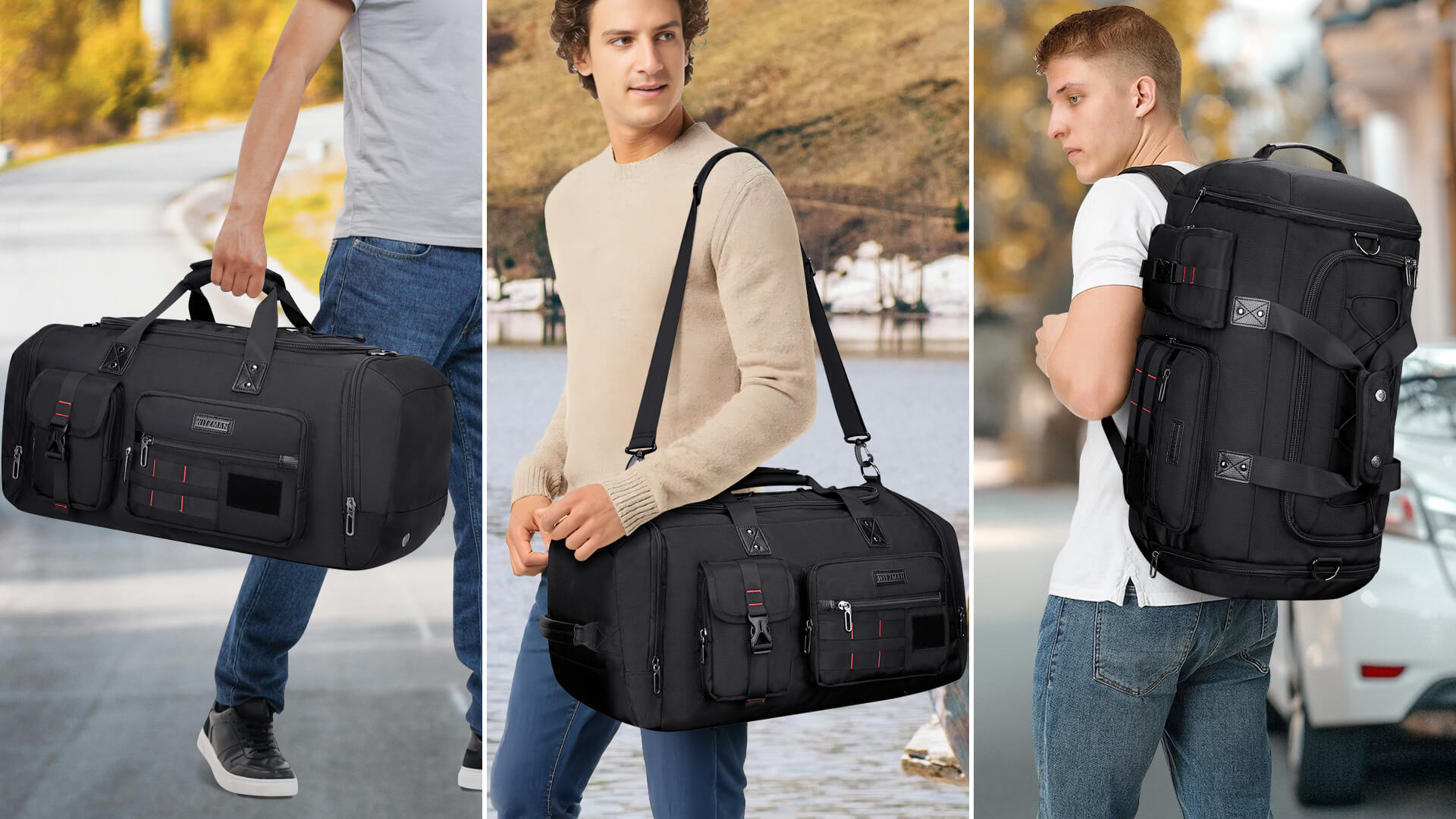Introduction
In the modern era of travel, the right backpack can make or break your journey. Whether you’re navigating a bustling airport, strolling through cobblestone streets, or trekking to remote destinations, a reliable travel backpack is indispensable. As airlines impose stricter carry-on restrictions and travelers demand greater convenience, selecting the perfect travel backpack has become more critical than ever.
At the heart of this decision are three pivotal factors: materials, dimensions, and features. Each plays a crucial role in determining a backpack’s durability, functionality, and overall suitability for your travel style. This guide dives deep into these aspects, offering insights to help you choose a travel backpack that not only meets but exceeds your expectations.
1. The Importance of Materials in Travel Backpacks
The materials used in a travel backpack are more than just a choice of fabric; they determine the product’s lifespan, comfort, and ability to withstand the rigors of travel. A well-informed choice can ensure your backpack remains a trusty companion for years.
1.1. Common Backpack Materials
Nylon: Nylon, particularly ballistic and ripstop varieties, is a favorite among manufacturers for its lightweight yet incredibly durable properties. Ballistic nylon offers superior abrasion resistance, making it ideal for frequent travelers. Ripstop nylon, characterized by its grid-like weave, prevents small tears from spreading, enhancing durability without adding weight.

-
Polyester: While slightly less durable than nylon, polyester remains a popular choice due to its affordability and decent resistance to UV damage. Backpacks made from high-denier polyester can offer a good balance between cost and performance.
-
Canvas: Known for its rugged aesthetic, canvas is a heavy-duty material often favored by travelers seeking a vintage or outdoorsy vibe. While it’s less water-resistant than synthetic fabrics, waxed canvas can provide some level of moisture protection and a long lifespan.

-
Leather Accents: Leather lends a premium and timeless appeal to backpacks. While rare in fully leather designs due to weight and cost, leather accents on straps or trims can elevate the style without compromising practicality.
1.2. Material Treatments for Performance
The raw fabric is just the starting point. Advanced treatments can significantly enhance a material’s functionality:
-
Waterproof Coatings: Polyurethane (PU) and thermoplastic polyurethane (TPU) coatings are common in travel backpacks, providing a layer of water resistance that protects your belongings from light rain.
-
DWR (Durable Water Repellent): A surface-level treatment that causes water to bead and roll off, DWR is ideal for travelers who may encounter unexpected weather.
-
Ripstop Construction: By weaving thicker threads at intervals, ripstop fabrics prevent small punctures or tears from spreading, ensuring longevity under demanding conditions.
1.3. Sustainable and Eco-Friendly Materials
As sustainability becomes a priority for many travelers, eco-friendly materials are gaining traction. Recycled polyester made from post-consumer plastic bottles is a popular choice, offering comparable durability to virgin polyester but with a reduced environmental footprint. Look for certifications like the Global Recycled Standard (GRS) to ensure authenticity.
Brands like Patagonia and Osprey are leading the charge, creating backpacks with sustainability in mind without compromising on performance or aesthetics.
2. Dimensions and Sizing: Perfecting Your Carry-On Fit
Choosing the correct dimensions for your travel backpack is crucial, especially with airlines tightening restrictions on carry-on sizes. Understanding these limitations and aligning them with your travel needs ensures hassle-free boarding and efficient packing.
2.1. Standard Carry-On Size Guidelines

Most airlines adhere to carry-on size limits of 22 x 14 x 9 inches (56 x 36 x 23 cm). However, these dimensions can vary slightly, particularly for international flights or budget carriers. A travel backpack designed to meet these requirements should fit seamlessly into overhead compartments while maximizing packing capacity.
Pro Tip: Opt for a slightly smaller backpack if you frequently fly on budget airlines, as their restrictions tend to be more stringent.
2.2. Volume and Capacity
Backpacks are often measured in liters, which indicates their internal capacity:
-
20-30L: Ideal for short weekend trips or minimalist packers.
-
30-45L: The sweet spot for most travelers, offering enough room for a week’s worth of essentials without exceeding carry-on limits.
-
45-60L: Better suited for extended trips, though some may push the boundaries of carry-on compliance.

Balancing capacity with compactness is key. Overloading a backpack not only risks exceeding airline limits but also compromises comfort during transit.
2.3. Ergonomics and Fit
A well-fitting backpack distributes weight evenly, reducing strain on your shoulders and back. Look for the following features:
-
Adjustable Straps: Ensure a snug fit across shoulders and hips.
-
Padded Back Panels: Enhance comfort and prevent items from digging into your back.
-
Chest and Waist Straps: Crucial for heavy loads, these straps redistribute weight to your hips, alleviating pressure on your shoulders.
3. Essential Features to Look for in a Travel Backpack
Features can make or break your travel experience. A thoughtfully designed backpack optimizes organization, enhances comfort, and adapts to varying travel scenarios.
3.1. Organizational Features

Multifunctional and large capacity Travel Backpack For men
-
Multiple Compartments: Dedicated pockets for laptops, tablets, and other gadgets keep electronics secure and easily accessible.
-
TSA-Friendly Designs: Lay-flat compartments that allow you to pass through airport security without removing your laptop are a game-changer for frequent flyers.
-
Hidden Pockets: Anti-theft pockets for passports, wallets, or other valuables add peace of mind in crowded spaces.
3.2. Comfort-Oriented Features
-
Ventilated Back Panels: Mesh panels promote airflow, keeping your back cool during long treks.
-
Ergonomic Shoulder Straps: Padding and contouring reduce pressure points.
-
Lightweight Frames: Aluminum or plastic frames provide structure without adding unnecessary weight.
3.3. Technology Integration
Modern backpacks cater to tech-savvy travelers:
-
USB Charging Ports: Allow on-the-go charging when paired with a power bank.
-
RFID-Blocking Compartments: Protect sensitive information from electronic theft.
3.4. Specialty Features
-
Expandable Designs: Provide flexibility for varying packing needs.
-
Compression Straps: Minimize bulk and help stabilize contents.
-
Water Bottle Holders: Ensure hydration is always within reach.
4. Balancing Aesthetics and Functionality
While practicality is paramount, a travel backpack should also align with your personal style. Finding the right balance between aesthetics and utility ensures you feel confident and prepared wherever you go.
4.1. Matching Your Style

-
Business travelers may prefer sleek, minimalist designs in neutral colors like black or gray.
-
Adventurers might gravitate toward bold colors or patterns that reflect their personality.
4.2. The Role of Design in Practicality
A clean, streamlined design often translates to easier handling and reduced snagging during transit. Padded handles, reinforced stitching, and durable zippers can add subtle yet significant enhancements to both style and functionality.
5. Top Recommendations: Travel Backpack Brands and Models
Explore trusted brands that offer exceptional travel backpacks:
-
Premium Choices: Osprey Farpoint 40, Nomatic Travel Backpack.
-
Budget-Friendly Options: REI Co-op Ruckpack, Samsonite Tectonic Lifestyle.
-
Eco-Friendly Picks: Patagonia Black Hole, Tropicfeel Shell Backpack.
6. Tips for Choosing the Perfect Travel Backpack
-
Prioritize your specific travel needs: short trips, tech organization, or outdoor adventures.
-
Research airline requirements and ensure your backpack meets size restrictions.
-
Try on backpacks in-store to assess comfort and fit, especially for extended use.
-
Look for warranties or repair policies for added peace of mind.
Conclusion
The right travel backpack is more than just a bag; it’s an investment in convenience, comfort, and style. By focusing on materials, dimensions, and features, you can find a carry-on companion that simplifies your journey and elevates your travel experience. Choose wisely, travel often, and let your backpack support every adventure ahead.



Share:
The Rise of the Duffle Bag: Trends, Innovations, and How to Choose the Perfect Travel Companion
The Ultimate Guide to Choosing the Perfect Travel Backpack